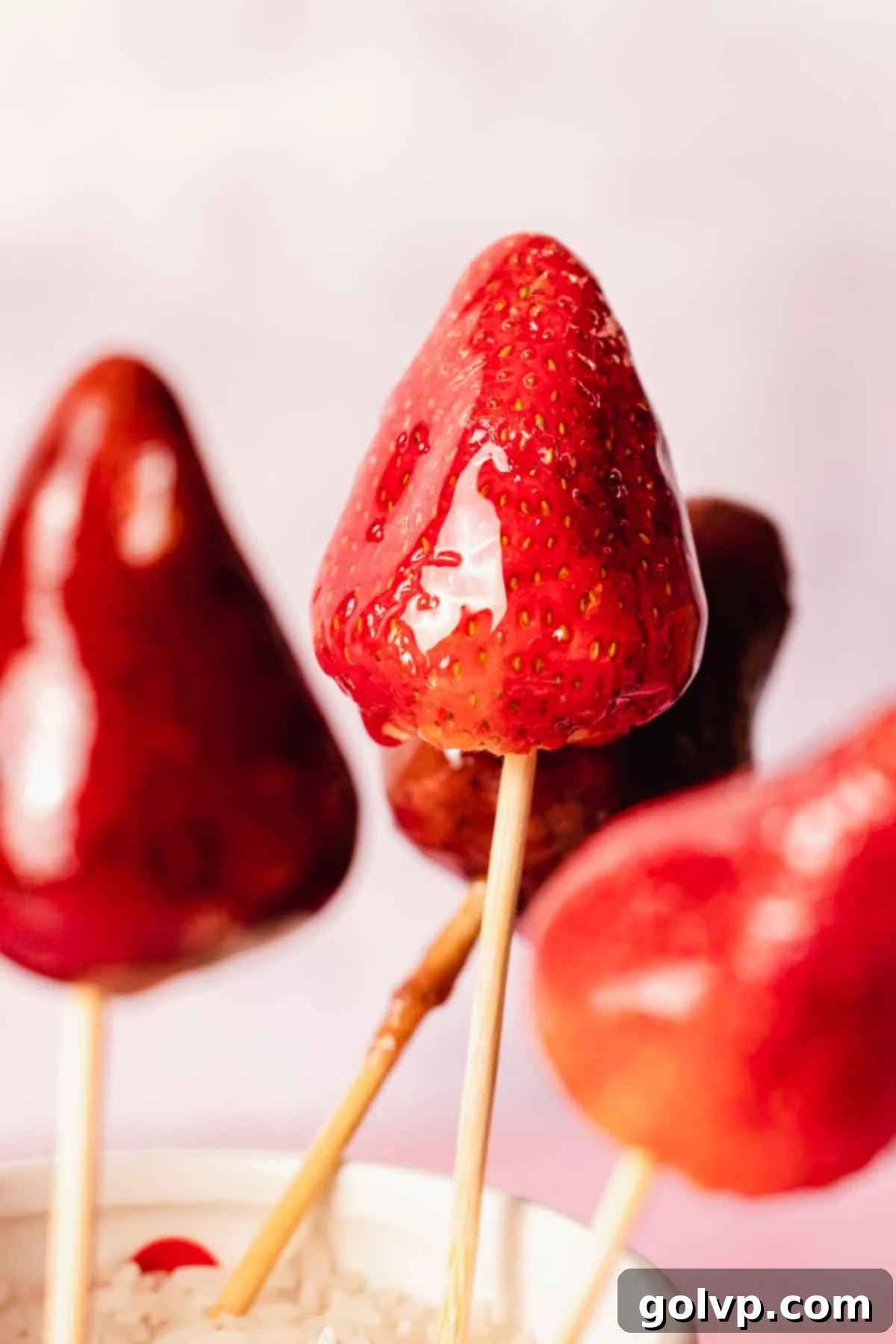The Best Homemade Strawberry Tanghulu Recipe: Crunchy & Sweet (with a Chocolate Twist!)
Prepare to be enchanted by the delightful crunch and juicy sweetness of homemade Tanghulu! This traditional Chinese candied fruit snack is incredibly simple to make, requiring just three core ingredients: sugar, water, and your favorite fresh fruit. While classic Tanghulu features hawthorn berries, this recipe focuses on vibrant, plump strawberries, creating an irresistible treat that’s both visually stunning and wonderfully delicious. We’ll also guide you through an exciting twist, showing you how to craft a decadent chocolate strawberry Tanghulu, perfect for those who crave an extra layer of flavor. Forget artificial corn syrup; our method sticks to tradition, ensuring a pure, glassy candy coating that shatters beautifully with every bite. Get ready to impress your taste buds and your friends with this easy, elegant, and incredibly satisfying dessert!
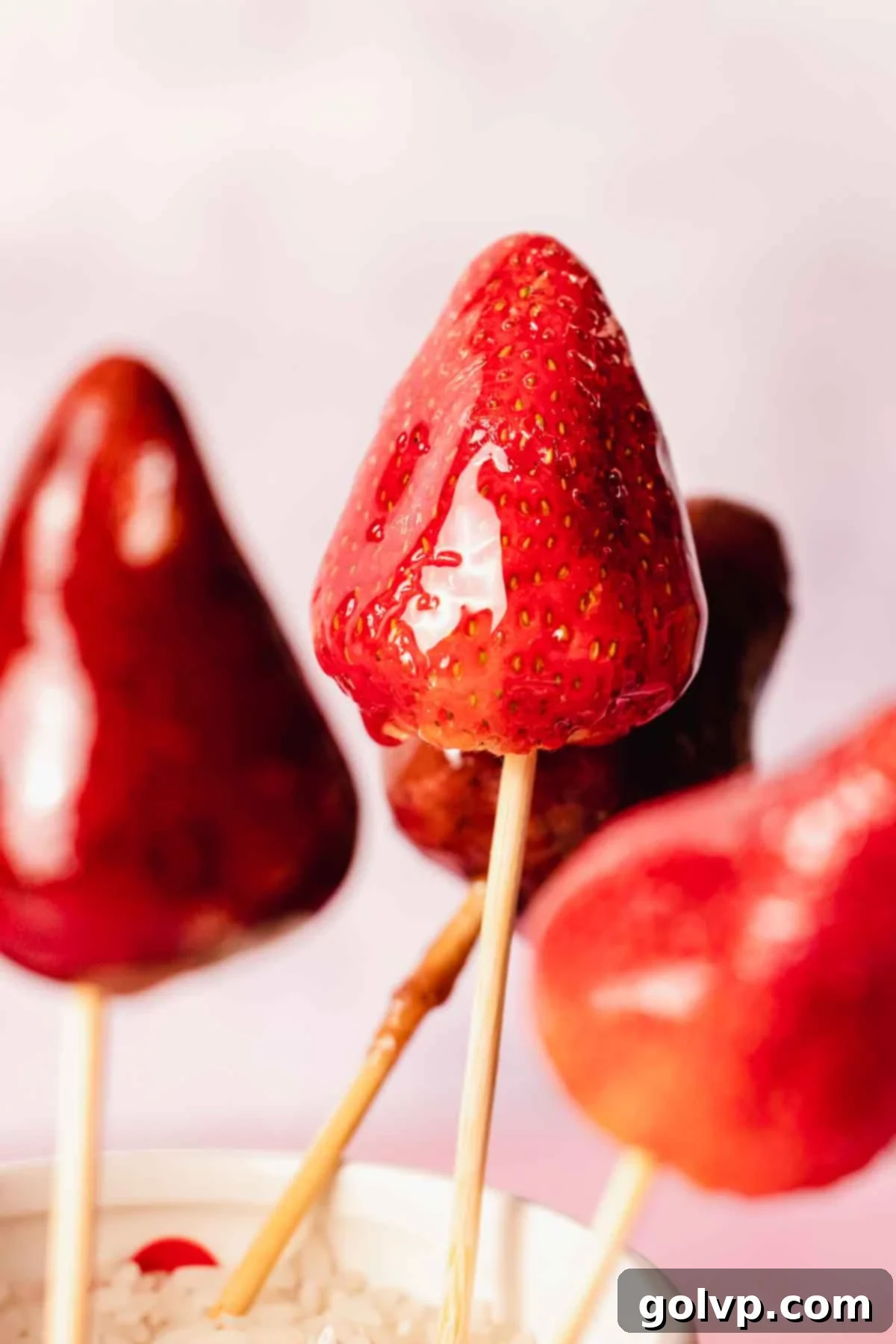
[feast_advanced_jump_to]
🍓 Why You’ll Adore This Easy Tanghulu Recipe
- Effortlessly Simple: You only need 3-4 basic ingredients (water being one of them!) and a straightforward process to create this gourmet-looking snack. It’s an ideal recipe for beginners and experienced home cooks alike, promising impressive results without extensive effort. Our traditional, corn syrup-free method is surprisingly quick, allowing you to whip up a batch in under 30 minutes!
- Unforgettable Crunchy & Juicy Texture: The magic of Tanghulu lies in its incredible textural contrast. Each piece offers a satisfyingly crisp, glassy sugar shell that gives way to a burst of sweet, fresh, and juicy strawberry. This delightful combination is truly addictive and makes Tanghulu a standout dessert that appeals to all ages. The hard candy shell provides a unique crunch that beautifully complements the soft, cool fruit inside.
- Classic & Chocolate Strawberry Tanghulu Options: This comprehensive guide not only teaches you how to master the traditional clear sugar coating, resulting in a shimmering, glass-like finish, but also provides an exciting step-by-step for a rich chocolate-infused version. Whether you prefer the pure sweetness of classic Tanghulu or a decadent chocolate twist, this recipe has you covered, offering versatility for different preferences and occasions. The chocolate version adds an extra layer of gourmet flavor to this already irresistible treat.
🍡 What Exactly is Tanghulu? The Ancient Chinese Candied Fruit Snack
Tanghulu (糖葫芦), pronounced “tong-hoo-loo,” is a beloved traditional Northern Chinese street food that dates back to the Song Dynasty (960-1279 AD). Its origins are steeped in history, with legends suggesting it was created to cure an emperor’s sick concubine. Historically, it consisted of hawthorn fruit (山楂, shānzhā) coated in a hard, transparent rock sugar shell, served on long bamboo skewers. The natural tartness of the hawthorn berries perfectly balanced the intense sweetness of the candy coating, creating a harmonious and refreshing flavor profile. Over centuries, this iconic snack evolved, and while hawthorn remains a classic choice, modern Tanghulu embraces a wide array of fresh fruits. Today, you’ll find everything from juicy strawberries, plump grapes, and refreshing kiwi slices to sweet mandarin orange segments, blueberries, blackberries, and even pineapples, all transformed into these dazzling, crunchy delights. The enduring allure of Tanghulu lies in its simple yet captivating combination of fresh fruit and a delicate, glass-like sugar candy shell, offering a unique sensory experience with every bite – a perfect blend of crispness and juiciness that makes it incredibly popular across Asia and increasingly around the world.
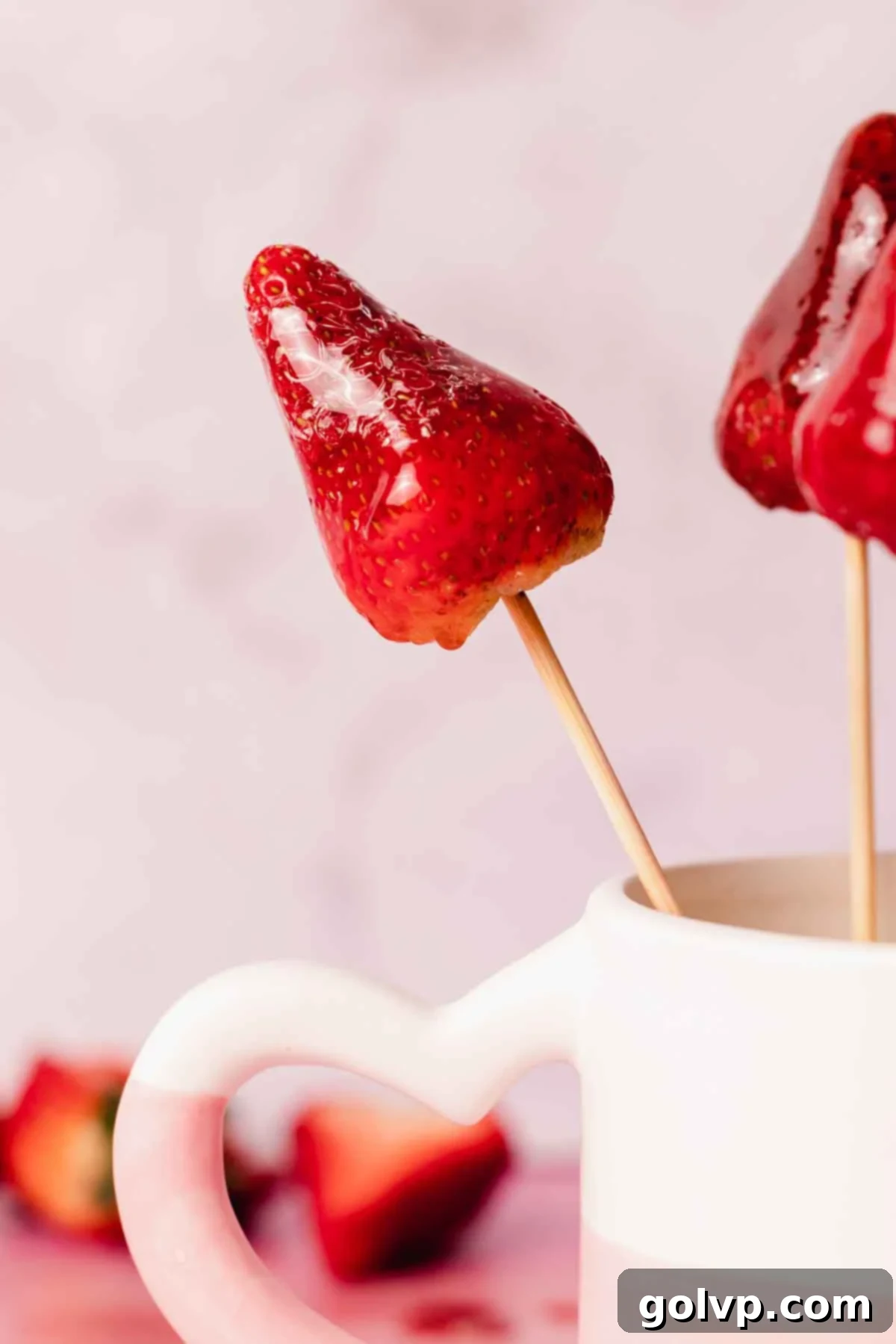
📝 Essential Ingredients for Perfect Tanghulu
Read through for all the tips you will need for success!
Full steps and ingredients in recipe card below.
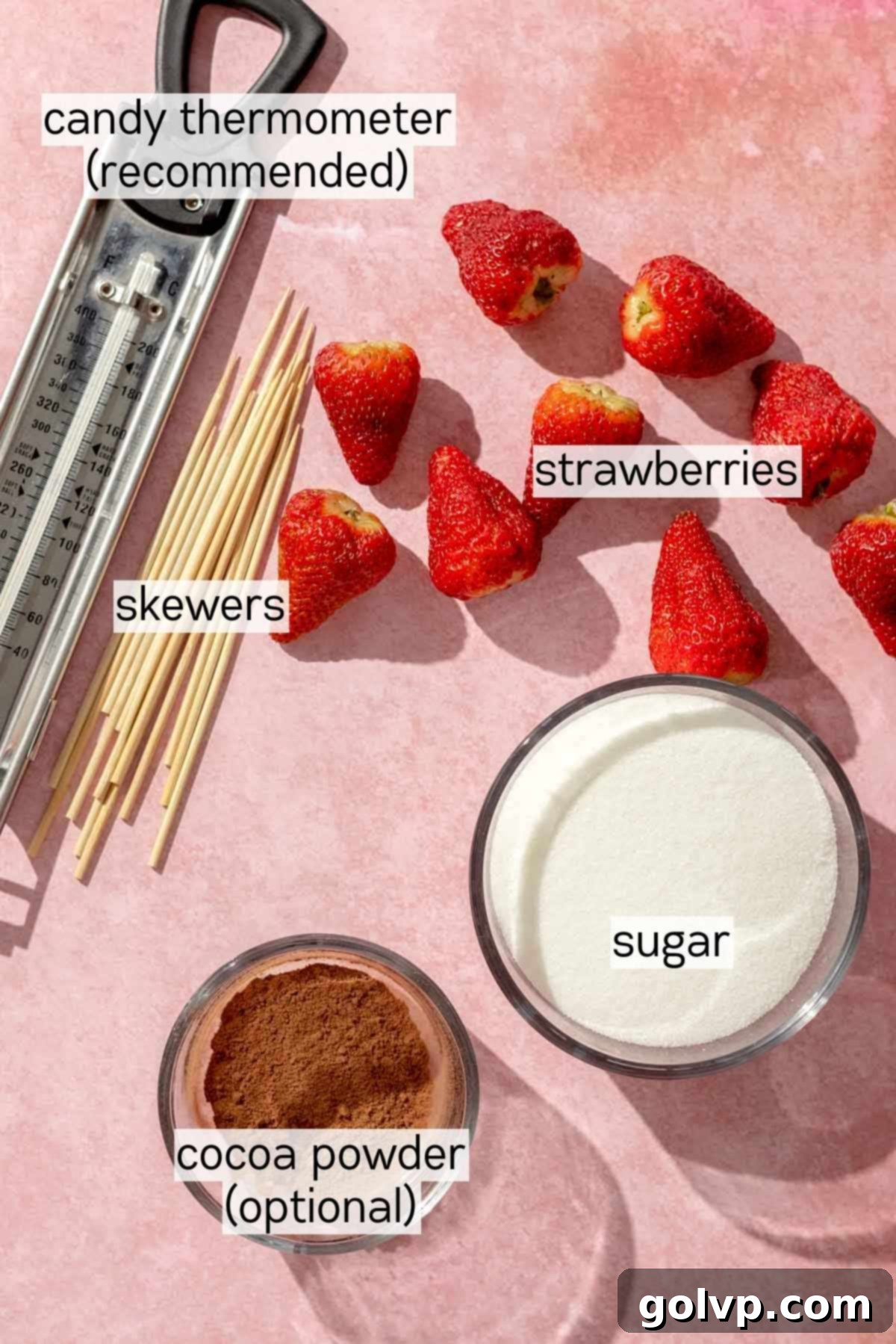
- Strawberries: The star of our show! It is absolutely crucial to select fresh, firm, and unbruised strawberries. Overripe strawberries contain too much moisture and will likely leak juice, causing the sugar coating to melt and become sticky rather than crunchy. Ensure they are thoroughly washed under cold water and, most importantly, completely dried with a clean towel or paper towels before coating. Any residual moisture will prevent the sugar syrup from adhering properly, leading to a frustratingly patchy or sliding coating. For extra firm results, you can even chill the washed and dried strawberries in the refrigerator for 15-20 minutes before dipping. If you happen to have an abundance of strawberries, consider making these delightful gooey strawberry cream cheese rolls or these sweet and chewy strawberry cheesecake cookies.
- Granulated Sugar: Also widely known as white sugar, this is your best friend for achieving that iconic glassy Tanghulu coating. Its fine, uniform crystals dissolve smoothly and consistently, giving you the lowest chance of premature crystallization (where the sugar turns grainy instead of forming a clear, hard shell). We strongly advise against using cane sugar, brown sugar, or unprocessed sugars, as their coarser crystals and natural impurities tend to crystallize more easily, often resulting in a gritty texture that won’t give you the desired clear, crunchy shell.
- Water: Simple, yet an absolutely essential component. Water serves as the solvent for the sugar, allowing it to reach the correct temperature and consistency for the candy coating. It’s important to use the specified amount to ensure the syrup boils correctly and reaches the hard crack stage efficiently.
- Cocoa Powder (Optional): For an indulgent and visually striking chocolate strawberry Tanghulu, a tablespoon of cocoa powder is a fantastic addition. Both natural (lighter color, slightly acidic flavor) and Dutch-processed (darker color, milder, richer chocolate flavor) cocoa powder will work, though Dutch-processed often provides a more intense chocolate experience. Make sure to sift it thoroughly before adding it to the syrup to prevent any lumps from forming in your beautiful chocolate coating.
✔️ Creative Fruit Substitutions for Tanghulu
While strawberries are phenomenal for Tanghulu, this candied fruit snack is wonderfully versatile! Feel free to experiment with other fruits and berries to discover your personal favorite. The key to successful substitutions is to choose fruits that are firm, not overly ripe, and have a relatively low moisture content to ensure the candy shell sets properly and remains crisp. Always wash and meticulously dry any fruit you choose before proceeding with the coating steps.
- Grapes: Both red and green grapes offer a delightful pop of juice and come in perfect bite-sized portions. They’re a classic alternative and hold their shape beautifully.
- Mandarins: Individual mandarin segments, when carefully peeled to remove all white pith and thoroughly dried, create a sweet and slightly tangy Tanghulu. Their natural juiciness is sealed within the crisp shell.
- Blueberries: Small and bursting with flavor, a cluster of blueberries on a skewer makes a charming and intensely fruity Tanghulu. Their small size means they coat quickly.
- Blackberries: Their unique texture and sweet-tart taste are excellent under a candy shell. Choose firm blackberries for the best results.
- Raspberries: Delicate and flavorful, they offer a soft, tender contrast to the hard candy. Handle them gently when skewering and dipping.
- Kiwi Slices: The vibrant green and tangy flavor of kiwi slices add a tropical twist. Cut them into thick, even rounds to make them easier to skewer and dip.
- Hawthorn Fruit: For the truly traditional experience, if you can find them in Asian markets, hawthorn berries are the authentic and original choice for Tanghulu. Their inherent tartness is famously complemented by the sweet sugar.
- Cherry Tomatoes: For an adventurous savory-sweet twist, some even use firm cherry tomatoes!
👩🍳 Step-by-Step: Crafting Perfect Strawberry Tanghulu
Caution: You will be working with extremely hot sugar that can reach dangerous temperatures (up to 285°F/140°C) and cause severe burns. Please exercise extreme caution and maintain focus. Use heat-safe gloves or oven mitts if needed, and always opt for longer bamboo skewers for the fruit, avoiding short toothpicks that bring your hands too close to the hot syrup.
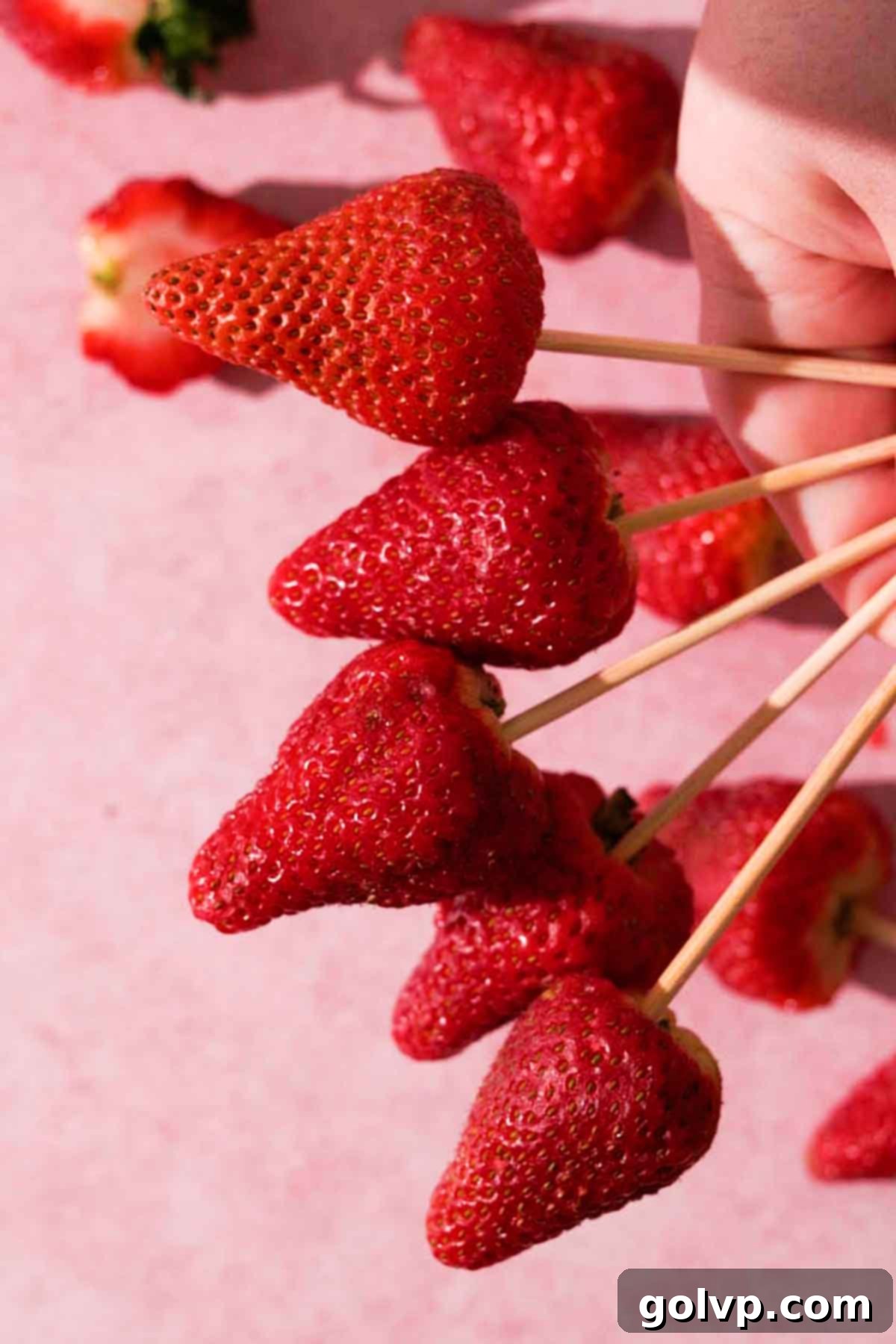
Step 1: Prepare Your Strawberries and Ice Bath. Begin by thoroughly washing your chosen strawberries (or other fruit) under cold running water. It is absolutely vital to dry them completely with a clean kitchen towel or paper towels; any lingering moisture will prevent the sugar from sticking. Carefully poke long bamboo skewers halfway through the base of each strawberry, ensuring they are securely fastened. Next, prepare an ice bath: fill a medium-sized bowl with cold water and plenty of ice cubes. Set this aside close to your cooking station, as you’ll need it immediately after dipping each fruit.
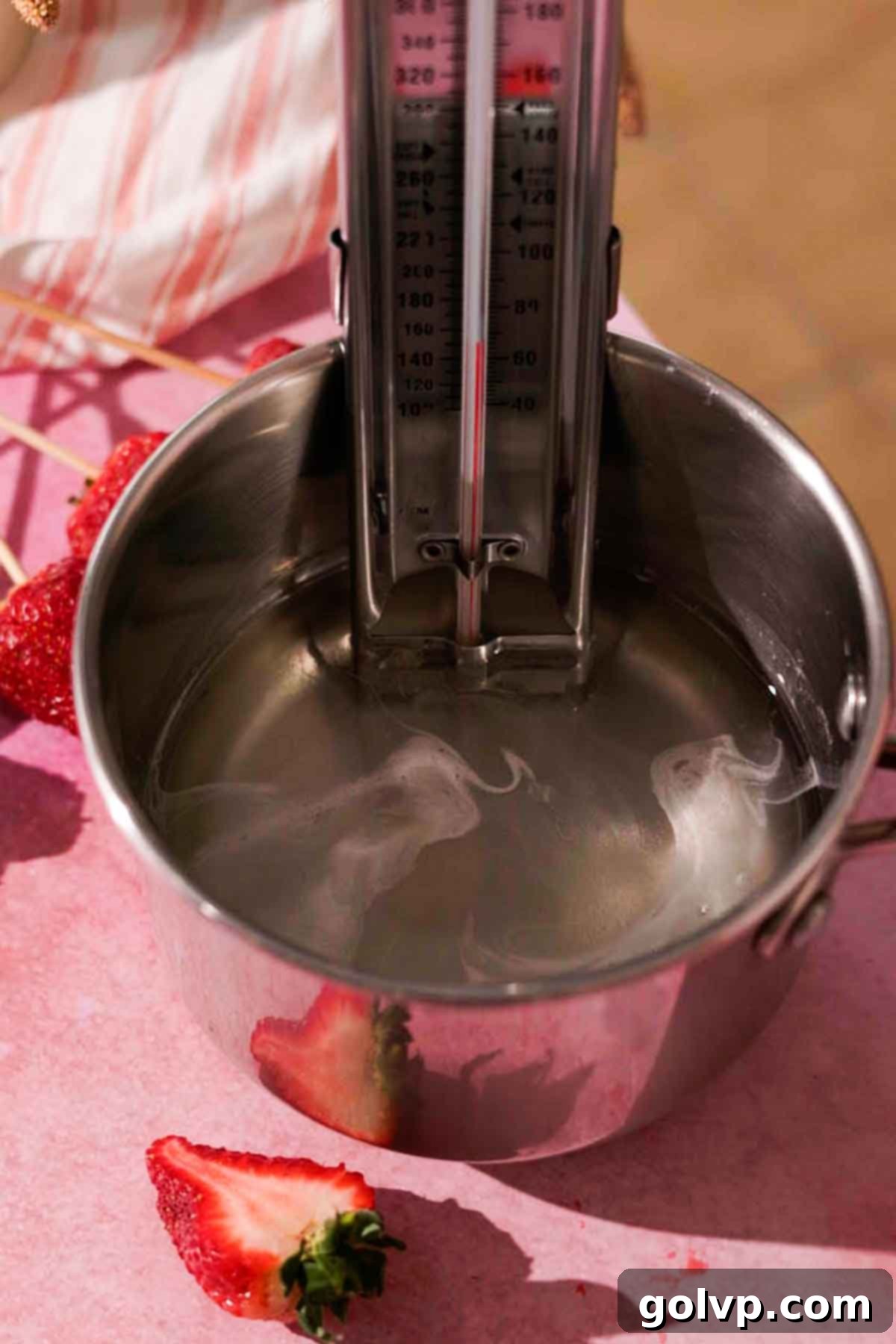
Step 2: Create the Sugar Syrup (No Stirring!). In a small, heavy-bottomed saucepan (this helps distribute heat evenly and prevents burning), combine the granulated sugar and water. Place the saucepan over medium-low heat. Bring the mixture to a gentle simmer, allowing the sugar to fully dissolve. At this stage, it’s crucial: **Do NOT stir the sugar syrup** once it begins to simmer and boil. Stirring can introduce sugar crystals from the sides of the pan back into the solution, leading to premature crystallization and a grainy, cloudy coating instead of a clear, smooth one. Attach a candy thermometer to the side of the saucepan, ensuring the tip is submerged in the syrup but not touching the bottom of the pan.
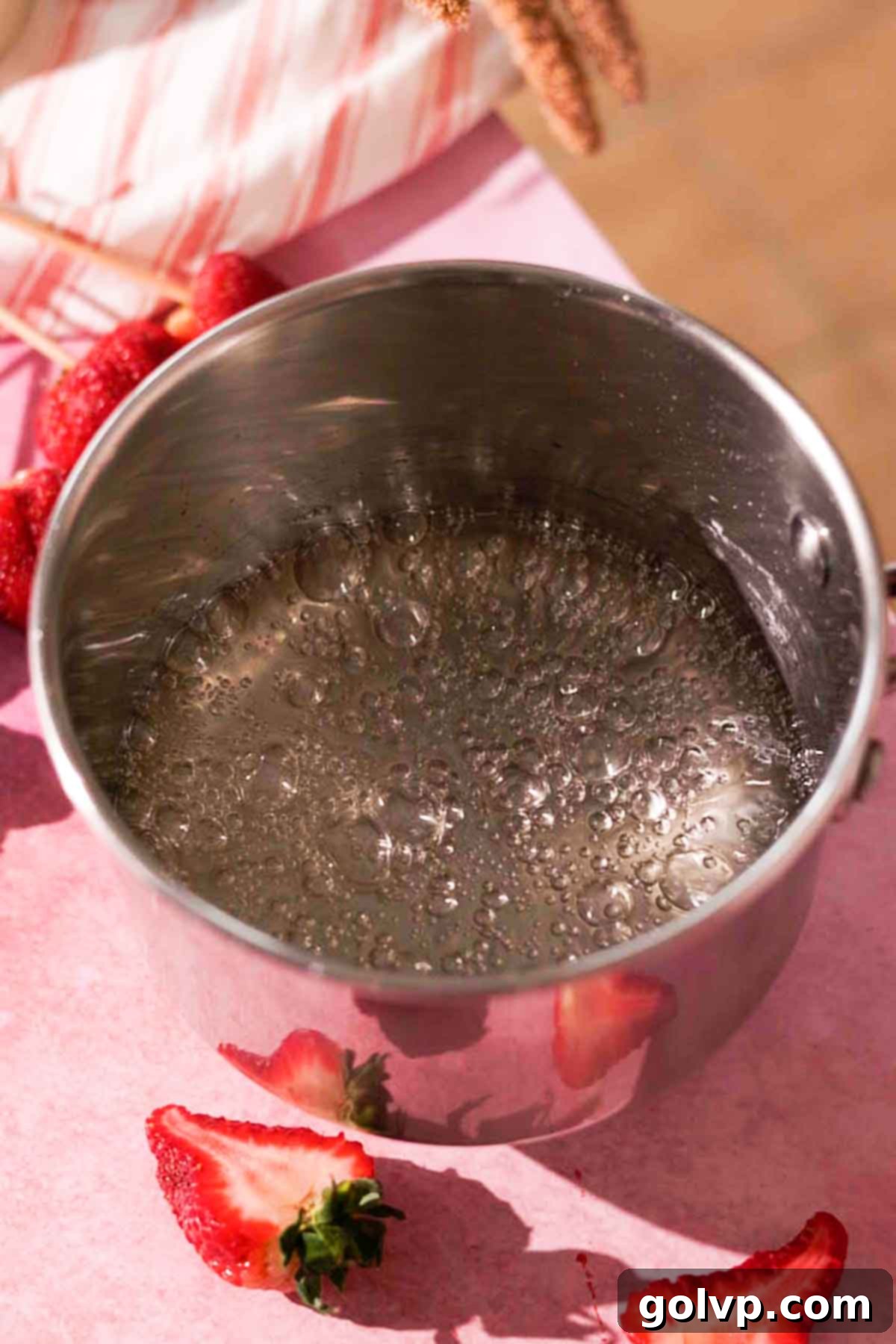
Step 3: Reach the Hard Crack Stage for Perfect Crunch. Continue to let the sugar syrup simmer gently without stirring until it reaches exactly 285°F (140°C) on your candy thermometer. This temperature is vital for achieving the “hard crack” stage, where the sugar will harden into a perfectly crisp, non-sticky coating that shatters beautifully. If you don’t have a candy thermometer, you can perform the “ice water test”: carefully drop a small amount of sugar syrup into your prepared ice water. If it immediately hardens and becomes brittle and crunchy when you break it, it’s ready. The syrup should also appear barely golden brown, a very pale amber hue, indicating it’s at the correct stage, avoiding a burnt taste.
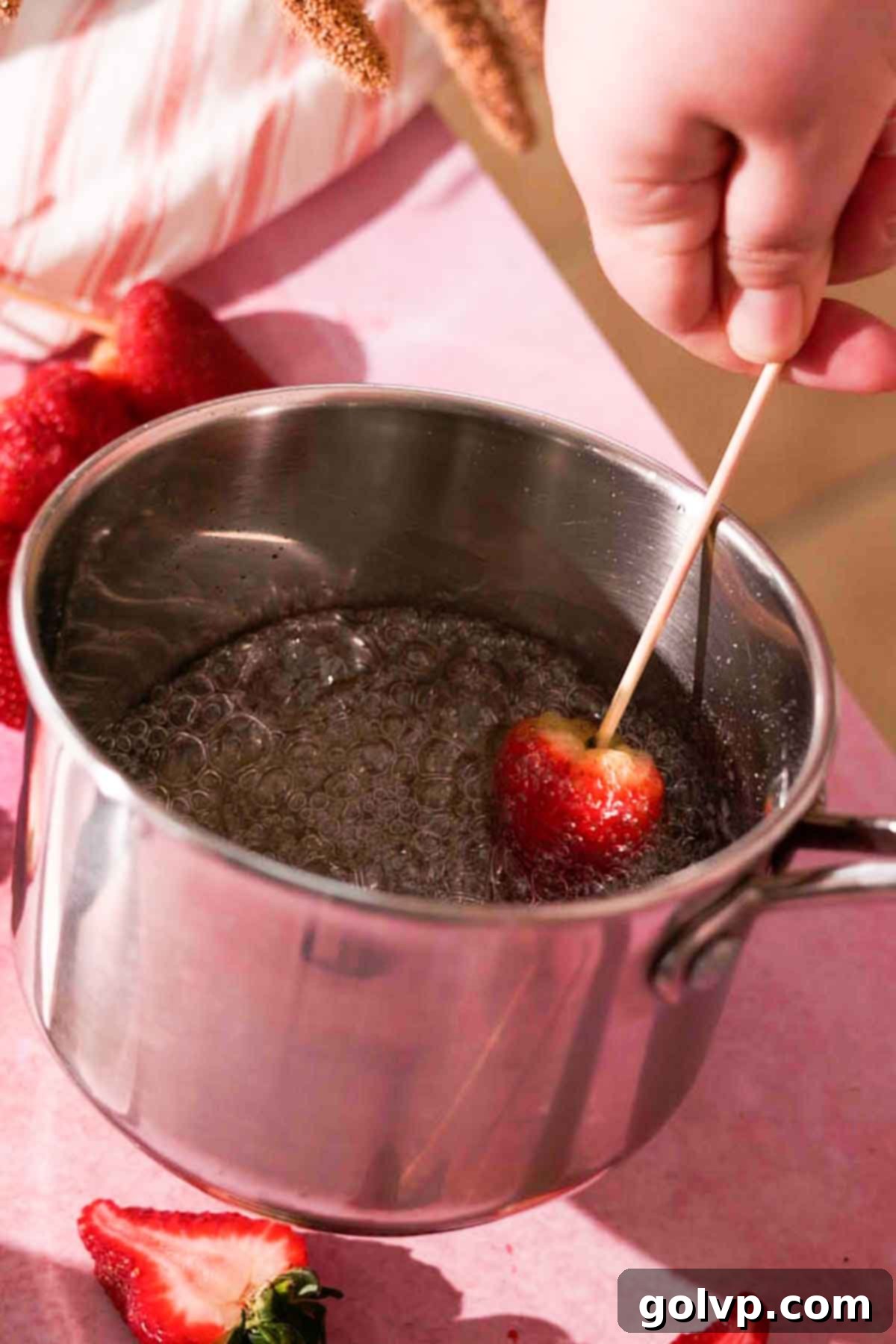
Step 4: Swiftly Coat the Strawberries. Once the syrup reaches the correct temperature, immediately remove the saucepan from the heat. Working quickly but carefully (remembering the syrup is extremely hot!), take one skewered strawberry and gently but briefly roll it in the hot sugar syrup. Ensure the entire strawberry is fully and evenly coated in a thin layer of candy. The syrup will begin to thicken and cool rapidly, so efficiency is key to ensuring a smooth, even coating on all your fruit.
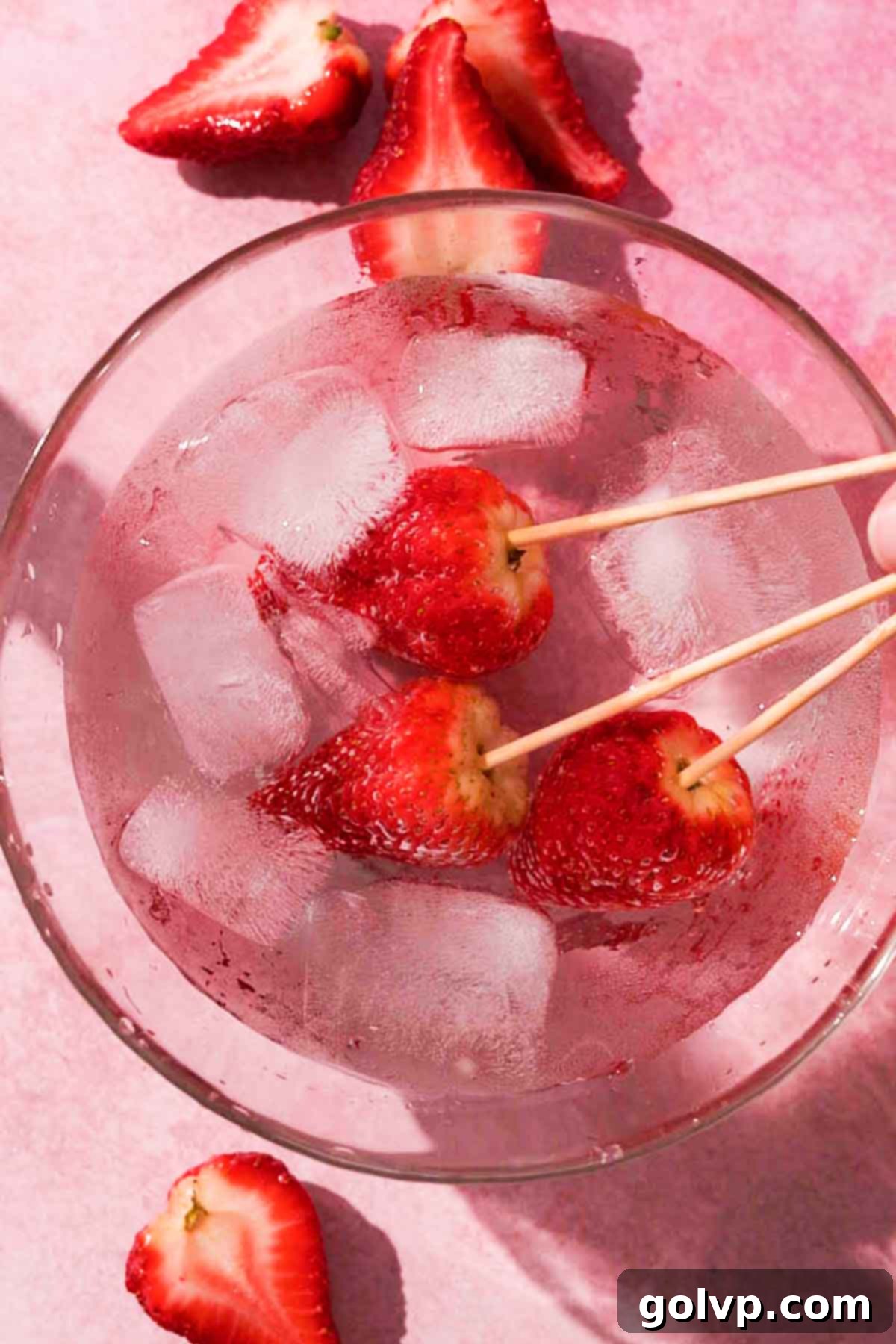
Step 5: Chill and Set the Coating in Ice Water. Immediately after coating each strawberry, dip the sugar-coated fruit into your prepared bowl of ice cold water. This quick dip rapidly cools and hardens the sugar shell, ensuring it sets into that desirable crisp, glassy, and non-sticky texture. It also plays a crucial role in keeping the strawberry itself cool and fresh, preventing it from cooking or becoming mushy in the residual heat of the sugar syrup. Swirl the fruit gently in the ice water for a few seconds until the candy is visibly firm and hard.
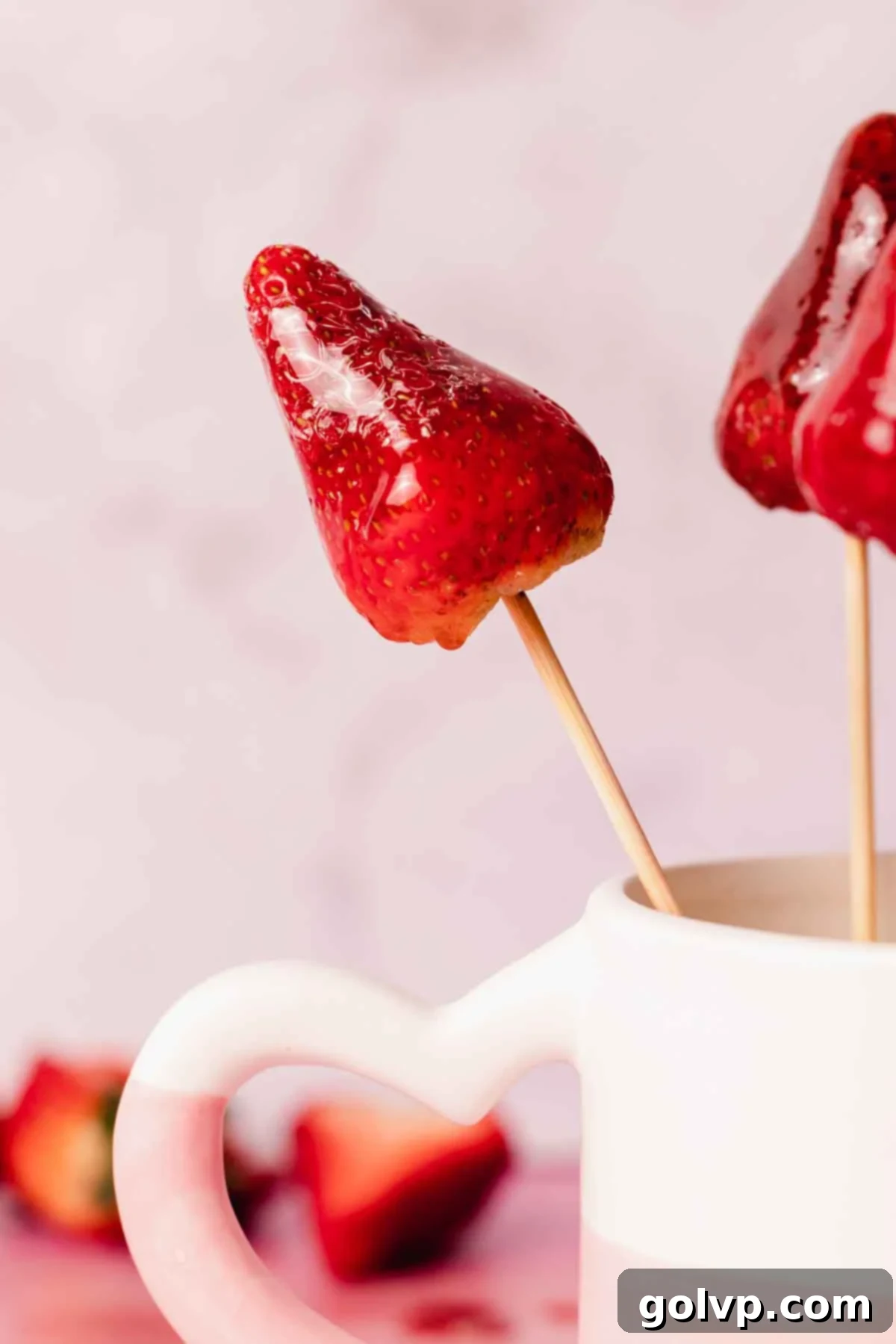
Step 6: Serve Immediately for Best Enjoyment! To properly dry and hold your beautiful Tanghulu upright without damaging the fragile candy coating, stand the skewers up in a tall glass filled with uncooked rice, granulated sugar, or any other small grain. This provides a stable base. For the ultimate experience, enjoy your Tanghulu as soon as it’s made, when the candy is at its crispiest, the fruit is at its freshest, and the contrast of textures is at its peak. This snack is all about immediate gratification!
Tip: While some recipes suggest placing coated Tanghulu on a greased and parchment-lined baking sheet to set, we highly recommend the ice water method. The rapid cooling from the ice water ensures a faster, harder, and more uniform set for the sugar and helps keep the fruit refreshingly cold, contributing to that perfect crunchy-cold contrast. This method significantly reduces stickiness!
👩🍳 How to Make Decadent Chocolate Strawberry Tanghulu
Adding a chocolate twist to your Tanghulu elevates this simple snack to a truly gourmet dessert, perfect for chocolate lovers. Follow these steps carefully to create a rich, chocolate-infused candy coating for your strawberries, keeping in mind that the process requires extra speed and precision due to the cocoa powder.
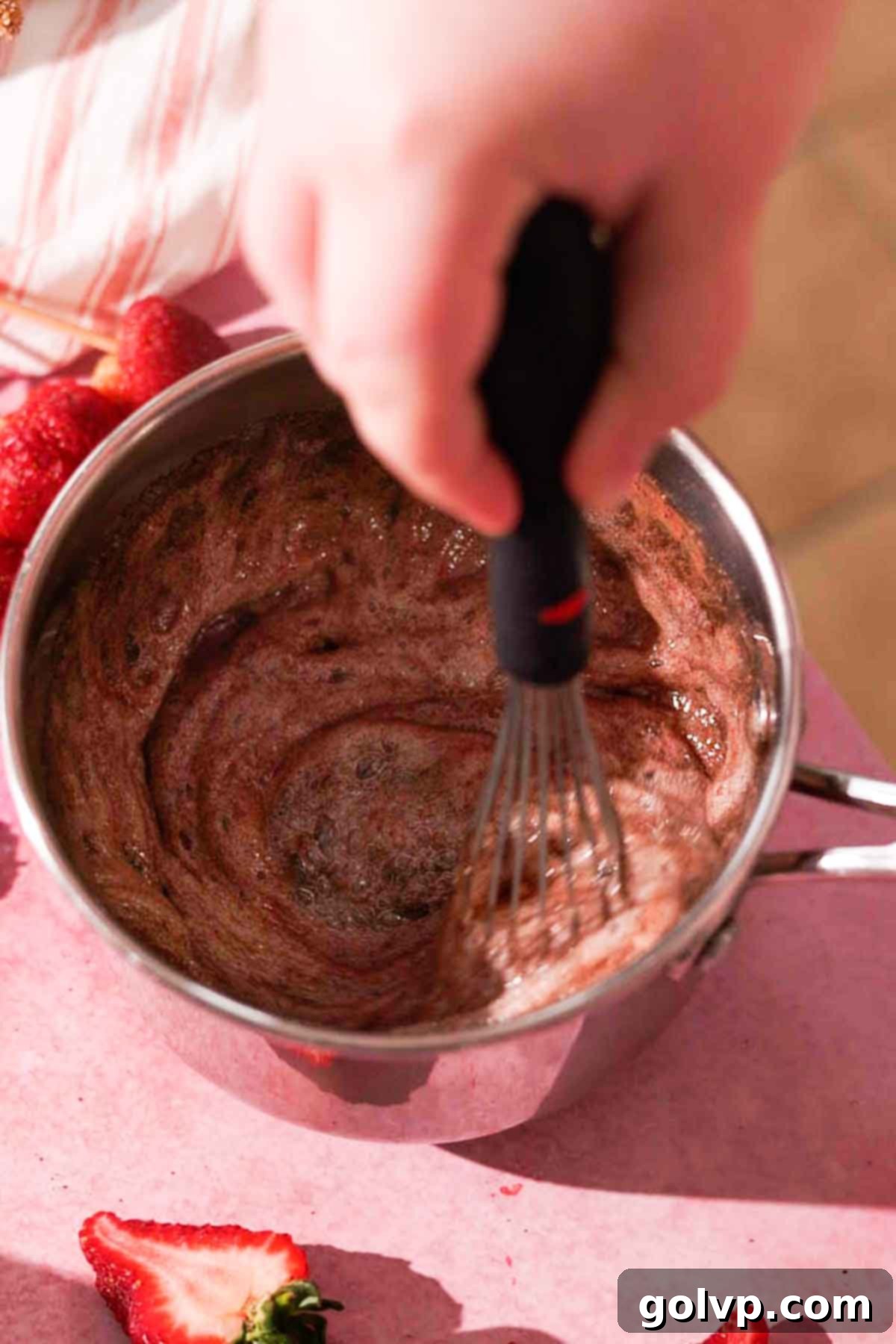
Step 1: Infuse the Syrup with Cocoa. First, complete steps 1-3 of the regular strawberry Tanghulu recipe to prepare your fruit and bring your sugar syrup to precisely 285°F (140°C). Once the syrup reaches this specific temperature, immediately remove the pan from the heat. Add the pre-sifted cocoa powder and whisk briefly but vigorously to combine it into the hot syrup. Be prepared, as the mixture will foam up considerably due to the introduction of the powder. Work quickly to incorporate the cocoa evenly.
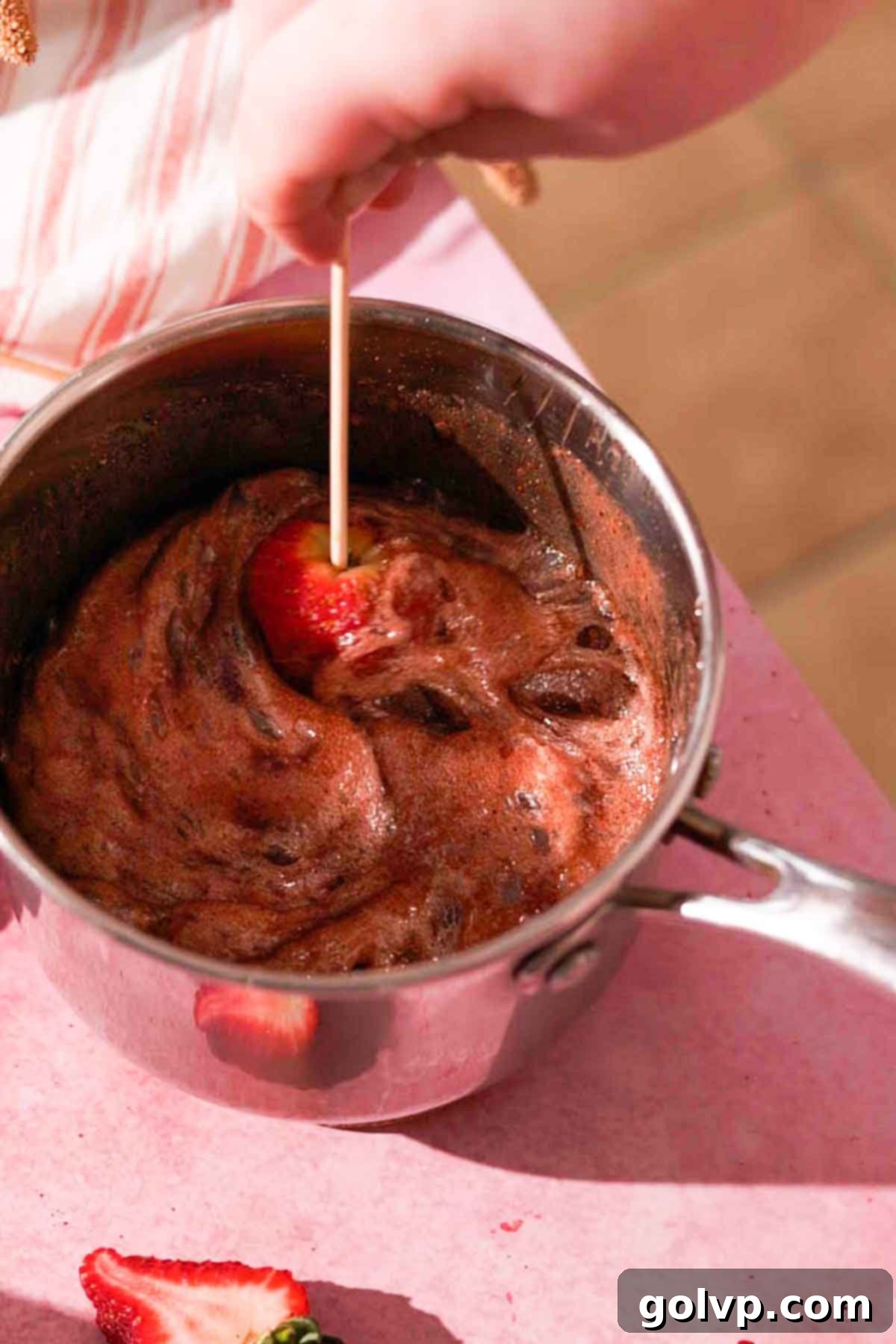
Step 2: Swift Dipping for Chocolate Coating. Once the cocoa is thoroughly mixed in, you must work with extreme speed. The addition of cocoa powder significantly increases the likelihood and speed of the sugar syrup crystallizing and hardening in the saucepan. Carefully and briefly roll the skewered strawberries in the hot, foaming chocolate sugar syrup, ensuring they are fully and evenly coated. It’s best to dip only a few strawberries at a time. If the syrup starts to seize or become too thick, you can briefly return it to very low heat to re-liquefy, but be mindful of burning. The faster and more efficiently you work, the better the result and the less crystallization you’ll encounter.
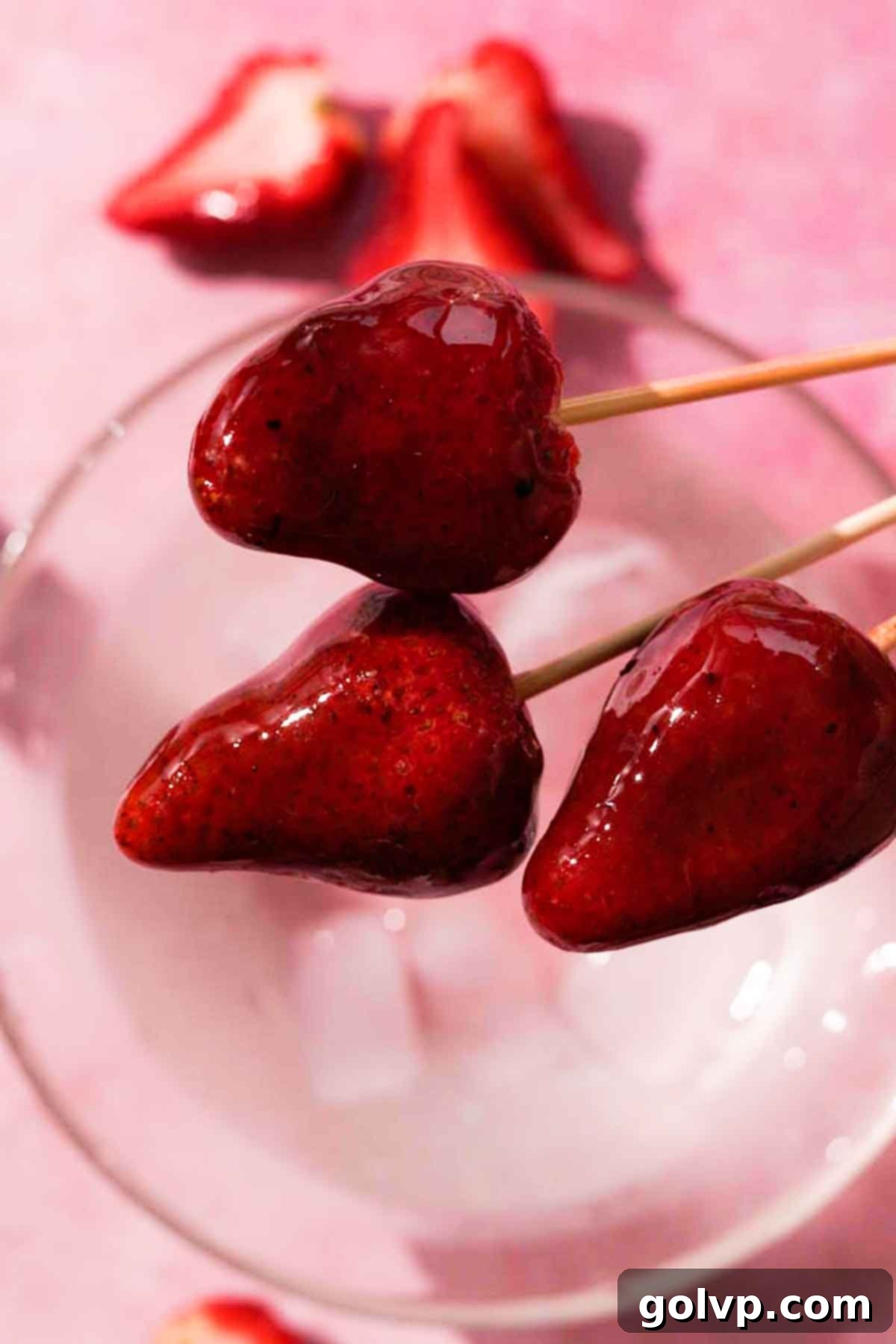
Step 3: Rapid Setting in Ice Water. Just like the classic version, immediately after coating, dip the chocolate-coated strawberries into your prepared bowl of ice cold water. This crucial step rapidly hardens the sugar, efficiently setting the beautiful chocolate shell and keeping the strawberries fresh and cool underneath. Swirl gently for a few seconds until the candy is firm and glossy.
Step 4: Display and Enjoy Instantly! Stand the finished chocolate Tanghulu skewers upright in a tall glass filled with uncooked rice, sugar, or any other small grain to allow them to fully set without touching anything and preserving their perfect shape. These chocolate-covered delights are best enjoyed immediately to experience the perfect contrast of the crisp, rich chocolate candy and the juicy, cool strawberry. The visual appeal of these treats is as wonderful as their taste – a truly luxurious take on a classic snack!
Expert Tanghulu Recipe Tips for Success:
- Select the Right Fruit: Always use firm, unbruised, and not-overripe strawberries or other fruits. This prevents excess moisture leakage, which can cause the sugar coating to become sticky or melt prematurely, ruining the crisp texture.
- Ensure Bone-Dry Fruit: After washing, meticulously dry your fruit with a clean towel or paper towels. Even a tiny bit of moisture on the fruit’s surface will create a barrier, preventing the sugar syrup from adhering properly and leading to a patchy, uneven, and unappealing coating. This step is non-negotiable for success!
- Resist the Urge to Stir the Syrup: Once your sugar syrup begins to simmer and boil, do NOT stir it. Stirring can introduce air bubbles and sugar crystals from the sides of the pan back into the solution, which will encourage the entire syrup to crystallize and become grainy, rather than forming a smooth, clear candy shell. Let physics do its work!
- Use a Candy Thermometer for Accuracy: While the ice water trick works, a reliable candy thermometer is the most foolproof way to ensure your sugar syrup reaches the precise “hard crack” stage (285°F/140°C). This exact consistency is critical for a perfectly crunchy, non-sticky coating every time.
- Utilize the Ice Water Bath: Dipping the coated fruit into ice water is a game-changer and a superior method. It not only sets the sugar coating instantly, creating that signature glassy crunch, but also helps to rapidly cool the fruit itself. This prevents the fruit from getting too hot and cooking through, keeping it fresh, firm, and juicy, which enhances the overall eating experience.
- Work Quickly, Especially with Chocolate: Sugar syrup cools and thickens rapidly, particularly when cocoa powder is added, as cocoa can accelerate crystallization. Have all your fruit prepped and your ice bath ready. Dip the fruit one by one, moving efficiently to ensure all pieces are coated before the syrup becomes too thick or crystallizes beyond use.
- Choose the Right Pot: A small, deep saucepan with a heavy bottom is ideal for making the sugar syrup. Its depth allows you to fully submerge the fruit without needing excessive amounts of syrup, and its smaller surface area helps maintain a consistent temperature more easily, minimizing evaporation and heat loss.
🥄 Make Ahead & Storage Tips for Tanghulu
Tanghulu, in its purest and most delightful form, is an ephemeral treat best enjoyed moments after it’s crafted. Unfortunately, it does not store well, and making it ahead of time is generally not recommended for optimal results. The beautiful hard candy shell is highly susceptible to moisture in the air (humidity is its worst enemy!) and the natural juices of the fruit. As time passes, the sugar coating will inevitably begin to absorb moisture from the atmosphere and draw it out from the fresh fruit itself. This unavoidable process causes the once-crisp candy to soften, become sticky, and eventually melt, completely losing its signature crunchy texture and glossy appearance. For this reason, we strongly advise against storing Tanghulu for more than a couple of hours, even in an airtight container or refrigerator.
Because this Tanghulu recipe is remarkably easy and quick to prepare (taking only about 25 minutes from start to finish), it truly shines when made fresh and consumed immediately. The joy of Tanghulu is in its instant gratification and ephemeral crunch. For those occasions when you need a dessert that *can* be prepared in advance, consider other delicious options like this incredible strawberry crunch cheesecake, which holds up beautifully in the refrigerator for days. If you’re looking for other fast and fun treats that don’t require immediate consumption, these quirky chocolate covered pickles or charming heart shaped chocolate chip cookies are also quick and easy to whip up without the immediate consumption pressure of Tanghulu.
❔ Absolutely! Here’s How to Make Chocolate Tanghulu
Yes, you absolutely can! Chocolate Tanghulu is a fantastic variation that adds a rich, cocoa-infused flavor to the crunchy candy coating, transforming the classic snack into a more indulgent dessert. To make it, you’ll prepare your sugar syrup as usual, bringing it to the “hard crack” stage (285°F or 140°C). Once it reaches this precise temperature, remove it from the heat and carefully add pre-sifted cocoa powder. Whisk it in briefly to combine, being mindful that the syrup will foam up significantly upon the cocoa’s introduction. Then, working as quickly as possible, dip and roll your skewered strawberries into this hot, foamy chocolate sugar syrup. Speed is of the essence here because the cocoa powder particles can act as nucleation points, causing the sugar to crystallize and harden much faster than the plain syrup. The resulting coating will have a beautiful dark brown tint and a subtle, satisfying chocolate flavor that complements the sweet and juicy fruit perfectly. Remember to dip them into an ice bath immediately after coating for the best set!
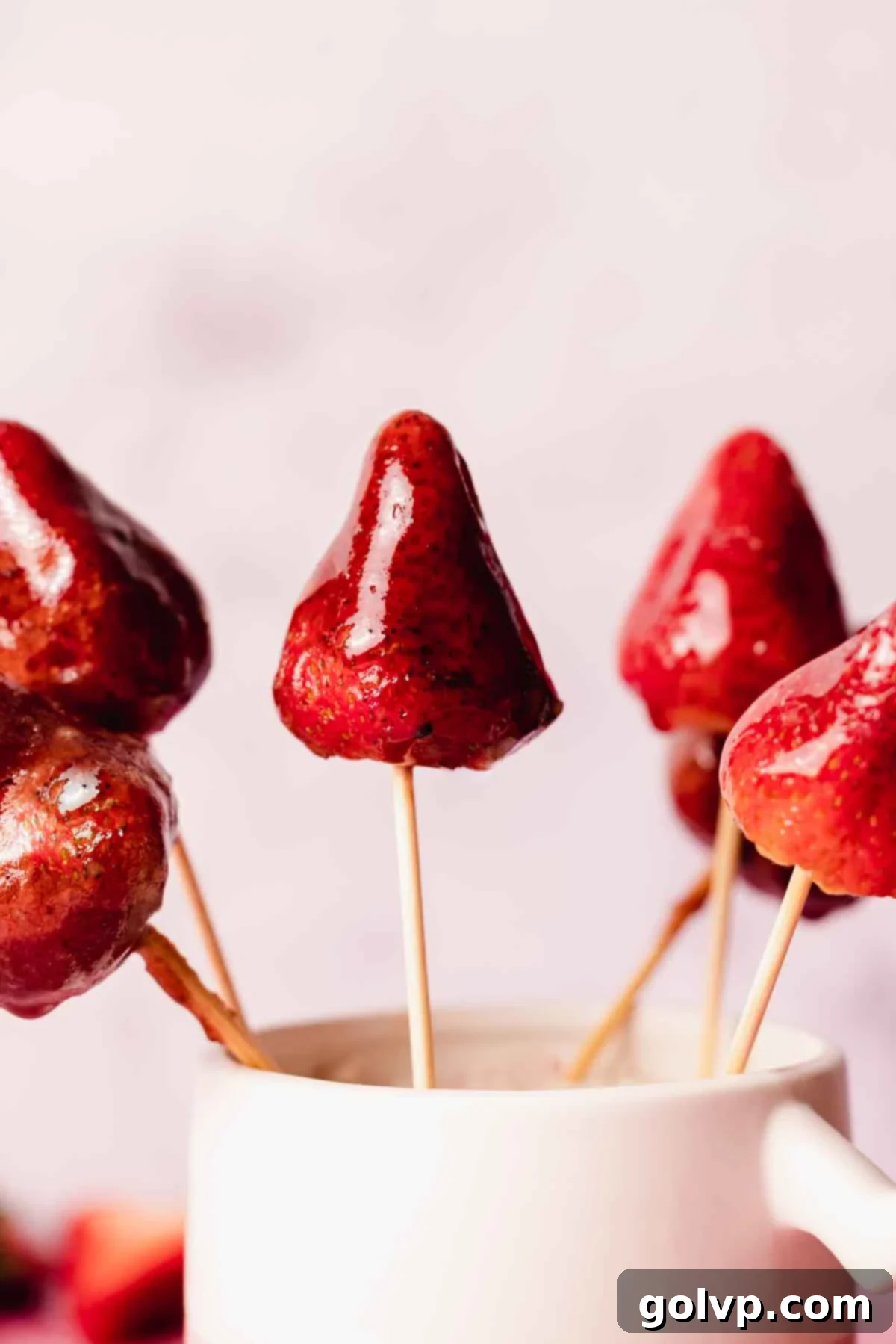
❔ Making Tanghulu Without a Candy Thermometer? Yes, You Can!
While a candy thermometer certainly takes the guesswork out and provides the most consistent, foolproof results, it is absolutely possible to make perfect Tanghulu without one. The key is mastering the “ice water test,” a traditional method that relies on careful observation. As your sugar syrup simmers, periodically drop a tiny amount of the syrup into a bowl of ice water that you’ve prepared beforehand. If the syrup immediately hardens into a brittle, crunchy thread that snaps easily when you remove it from the water, it has reached the “hard crack” stage (approximately 285°F/140°C) and is ready for dipping. Additionally, the syrup itself should have a very pale, barely golden-brown tint, indicating it’s at the correct stage without being burnt. This method requires a bit more practice and keen observation, but it’s a reliable alternative for achieving that perfect crisp coating. If you enjoy making desserts that don’t always require specialized tools, you might also like these salted caramel apple pie bars, which are equally delicious and simple to prepare.
📖 Tanghulu Recipe FAQs: Troubleshooting & Expert Tips
Crystallization is a common issue with sugar syrups, but it’s easily avoidable with the right technique! The main culprit is stirring the sugar syrup once it starts to simmer. Stirring can introduce sugar crystals from the sides of the pan or from your spoon back into the mixture, triggering a chain reaction that causes the entire batch to turn grainy and cloudy instead of forming a clear, hard, and smooth shell. Always let it simmer undisturbed. If it does crystallize, don’t despair completely! You can sometimes rescue it by adding another half cup of water and gently reheating until the sugar dissolves again, then restart the simmering process, strictly without stirring. When making chocolate Tanghulu, the cocoa powder itself can act as a seed for crystallization; therefore, it’s crucial to work very quickly once the cocoa is added and the mixture foams up.
Cleaning a pot with hardened sugar can seem daunting, but it’s surprisingly simple and requires no scrubbing! Just pour enough water into the pot to cover the hardened sugar residue. Place the pot back on the stove and bring the water to a simmer over medium heat. As the water gently heats and simmers, it will gradually dissolve the sugar back into a liquid state. This process eliminates the need for any vigorous scrubbing, making cleanup a breeze. Once dissolved, simply pour out the sugary water and wash the pot as you normally would.
Yes, one common trick to prevent crystallization, often used in candy making, is to add about ¼ cup of light corn syrup along with the granulated sugar and water at the very beginning of the cooking process. Corn syrup is an “invert sugar” that chemically interferes with the crystallization process of regular sugar, helping the syrup remain smooth, clear, and stable. While effective and widely used, keep in mind that using corn syrup is not part of the traditional two-ingredient (sugar and water) Tanghulu method, so it slightly alters the authenticity. However, it’s a reliable method if you’ve struggled with crystallization in the past and want extra assurance.
Drying the fruit thoroughly is paramount for successful Tanghulu. If the fruit’s surface has any lingering moisture, it creates a physical barrier between the hot sugar syrup and the fruit. This barrier prevents the hot sugar from properly adhering to the fruit, causing the candy coating to slide off, resulting in a patchy, uneven, and often sticky shell. A perfectly dry surface ensures the sugar syrup forms a smooth, unbroken, and crisp layer that will beautifully encase your fruit.
You can certainly double the recipe if you are making the regular, clear sugar Tanghulu. However, we strongly advise against doubling the chocolate Tanghulu recipe. The cocoa powder significantly accelerates the crystallization process, meaning the syrup will likely harden and crystallize in your saucepan before you have a chance to dip all the strawberries in a larger batch. For chocolate Tanghulu, it’s best to stick to single batches or make two separate small batches back-to-back to ensure optimal results and minimize waste.
For the best results, use a small, heavy-bottomed saucepan. The heavy bottom helps distribute heat evenly and prevents scorching of the sugar. A small, deep pot is ideal because it allows you to fully submerge the fruit into the syrup without needing to make an excessively large batch of candy, and it helps maintain the syrup’s temperature more consistently, which is crucial for achieving the hard crack stage.
Achieving a crystal-clear, glossy coating depends on a few critical factors: ensuring the fruit is bone-dry before dipping, strictly avoiding stirring the sugar syrup once it begins to simmer, and precisely reaching the “hard crack” temperature (285°F/140°C). Additionally, dipping the coated fruit into an ice bath immediately after coating helps to lock in that glossy finish by rapidly setting the sugar before it has a chance to cool slowly and potentially become cloudy or dull.
🍓 More Delightful Strawberry & Dessert Recipes
- Strawberry Cheesecake Cookies
- Fresh Strawberry and White Chocolate Cupcakes
- Strawberry Cinnamon Rolls
- Matcha Tiramisu
Did you make this recipe? I would love for you to rate this recipe and hear what you think in the comments below! Share your creation on Instagram and tag @flouringkitchen. Follow me on Pinterestto save and for more recipe ideas.
📖 Recipe Card
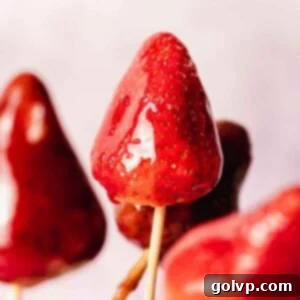
Tanghulu Recipe: Perfect Crunchy Candied Strawberries
Mary
Pin Recipe
Shop Ingredients
Equipment
-
candy thermometer optional but recommended for accuracy
-
small, heavy-bottomed saucepan
-
long bamboo skewers
-
medium bowl (for ice bath)
Ingredients
- 10 large, firm strawberries washed and thoroughly dried
- 1 cup granulated sugar (white sugar is best for clarity and crunch)
- ½ cup water
- 1 tablespoon cocoa powder (optional, sifted for chocolate tanghulu)
Shop Ingredients on Jupiter
Instructions
-
1. Prepare Fruit & Ice Bath: Wash and thoroughly dry your chosen strawberries (or other fruit). Poke long bamboo skewers halfway through the base of each strawberry. Prepare a large bowl of ice water (cold water with plenty of ice cubes) and set it aside near your stovetop.10 large strawberries
-
2. Make Sugar Syrup (No Stirring!): In a small, heavy-bottomed saucepan, combine the granulated sugar and water. Place over medium-low heat. Bring to a gentle simmer to fully dissolve the sugar. Once simmering, it is CRUCIAL that you do NOT stir the sugar syrup, as this can cause crystallization. Attach a candy thermometer to the side of the pan, ensuring the tip is submerged but not touching the bottom.1 cup granulated sugar, ½ cup water
-
3. Reach Hard Crack Stage: Let the sugar syrup continue to simmer gently without stirring until it reaches precisely 285°F (140°C) on your candy thermometer. If you don’t have a thermometer, perform the “ice water test”: drop a tiny amount of syrup into ice water. If it immediately hardens and becomes brittle and crunchy, it’s ready. The syrup should also have a very pale, barely golden-brown tint.
-
4. Coat Strawberries (Classic Tanghulu): Immediately remove the saucepan from the heat. Working quickly but carefully, take one skewered strawberry and gently but briefly roll it in the hot sugar syrup to get it fully and evenly coated in a thin layer of candy. Proceed to step 6.
-
5. For Chocolate Tanghulu: If making chocolate Tanghulu, once the syrup reaches 285°F (140°C) (from step 3), remove from heat, add the sifted cocoa powder, and whisk briefly but vigorously until combined (the mixture will foam up significantly). Then, working extremely quickly, dip and roll the skewered strawberries in this hot, foaming chocolate sugar syrup. Work very fast as cocoa powder accelerates crystallization.1 tablespoon cocoa powder
-
6. Set the Coating with Ice Water: Immediately after coating each strawberry (whether classic or chocolate), dip it into your prepared bowl of ice cold water. Swirl gently for a few seconds until the sugar shell hardens and becomes completely firm and glossy. This rapid cooling ensures a crisp, non-sticky finish and keeps the fruit fresh.
-
7. Serve Immediately: To allow the Tanghulu to fully set without touching anything, stand the skewers upright in a tall glass filled with uncooked rice, granulated sugar, or any other small grain. Enjoy your perfectly crisp and juicy Tanghulu immediately for the best taste and texture experience!
Notes
- Fruit Selection: Always use firm, unbruised, and not-overripe fruits. This prevents premature moisture leakage, ensuring a firm candy coating.
- Dry Fruit is Key: After washing, meticulously dry your fruit with a clean towel. Any moisture will prevent the sugar syrup from adhering properly.
- No Stirring Rule: Once the sugar syrup begins to simmer, do NOT stir it. Stirring introduces crystals that can make the entire batch grainy.
- Temperature Precision: Use a candy thermometer to accurately reach the “hard crack” stage (285°F/140°C) for a perfectly crisp, non-sticky coating. The ice water test is a good alternative if a thermometer isn’t available.
- Ice Water Advantage: Dipping the coated fruit into ice water instantly sets the sugar, creating a glossy crunch, and keeps the fruit refreshing and cool.
- Speed Matters: Work very quickly when dipping, especially with chocolate Tanghulu, as the syrup cools and crystallizes fast.
- Ideal Pot Size: A small, deep saucepan is recommended to easily submerge fruit and maintain consistent syrup temperature.
